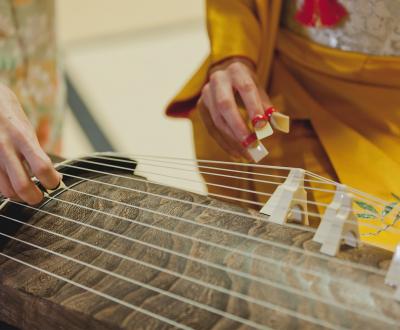Japanese Koto
The Traditional Japanese Harp
Koto is a traditional music instrument played by plucking its string, in the same way as the shamisen. It is a zither with a long body and is usually called the "Japanese harp" due to the melodious sounds it produces. It is a typical musical art of Japan.
The koto was imported from China between the 7th and 8th centuries and was played at the Imperial Court in Nara (710-794). It first performed gagaku, the official musical repertoire of Court music in Japan. Over time, the use of koto democratized, notably thanks to Yatsuhashi Kengyo, a 17th century shamisen musician who became the first to play koto for the general public and is now considered the "Father of Modern Koto". He participated in the composition of Rokudan no shirabe, one of the most iconic koto pieces.
Geishas favor playing koto during entertainment performances for its soft and sensitive musical touch. Nowadays, the Japanese harp is taught in school and is one of the traditional instruments that are the most popular and widely played.
A koto is characterized by the following elements:
- Dimensions of about 1,80 meters long and about twenty centimeters wide,
- 13 silk strings (some types of koto can have up to 32 strings),
- A slightly bent body and sounding board, made from Paulownia wood,
- High ivory bridges, movable to tune the instrument.
How to play the koto
Traditionally, the musician kneels in the formal sitting position called seiza, while the koto is placed horizontally on the floor. However, since Meiji era (1868) and the introduction of western habits in Japan, koto can now be played seating on a chair with the instrument placed on a stand. Thus, the angle between the musician’s right leg and the instrument is wider by 45 degrees.
To play the koto, the right hand’s thumb, forefinger and middle finger are fitted with ivory plectrums (tsume or "claws"), that will help plucking the strings. The left hand is used to move the bridges and modify the tone of the musical notes. As with many string instruments, left-handed persons must adapt to play the koto as there is no specific version for them.
Koto partition for beginners
The musical scores show the notes, but also the name of the strings to pluck. Strings 1 to 10 are just numbered, and strings 11 to 13 are respectively named斗 to, 為 i and, 巾 kin.
One of the most played part during a koto introduction is named Sakura 🌸. This piece’s score was simplified and includes only strings 3 to 9. Therefore, only the thumb is plucking the strings, while the left hand is resting as no tone modification is necessary.
With a little focus and knowledge of solfeggio, it is possible to play this melody after only thirty minutes of practice, which comes as a nice surprise for the student. The instrument is naturally quite difficult to master, but it is nonetheless rewarding for beginners, who can still feel the beauty of its sounds thanks to a couple of notes.
The video below was shot during an introductory course to koto in Fukuyama City in Hiroshima prefecture. The city is one of the renowned places for the fabrication of this charming traditional instrument.
It is possible to experience learning koto throughout Japan, from ¥4,000 (~US$25.58) per person, depending on the cultural center.

